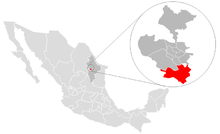Santiago, Nuevo León
You can help expand this article with text translated from the corresponding article in Spanish. (August 2024) Click [show] for important translation instructions.
|
Santiago | |
|---|---|
| Motto: Cultura y Progreso | |
 | |
| Coordinates: 25°26′N 100°08′W / 25.433°N 100.133°W | |
| Country | Mexico |
| State | Nuevo León |
| Founded | 1648 |
| Founded by | Diego Rodríguez de Montemayor |
| Government | |
| • Mayor | David de la Peña Marroquin (PRI) |
| Area | |
| • Municipality | 739.2 km2 (285.4 sq mi) |
| • City | 68.47 km2 (26.44 sq mi) |
| Elevation | 445 m (1,460 ft) |
| Population | |
| • Municipality | 46,784 |
| • Density | 63/km2 (160/sq mi) |
| • Metro | 5,341,177 |
| • City | 43,019 |
| • City density | 630/km2 (1,600/sq mi) |
| Time zone | UTC-6 (Central Standard Time) |
| • Summer (DST) | UTC-5 (Central Daylight Time) |
| Website | www |
Santiago is a municipality and city located in the center of the Mexican state of Nuevo León. It is part of the Monterrey metropolitan area and its area comprises around 739.2 km².[3] According to the 2020 census, it had a population of 46,784.
"La Boca" Dam, one of the water reservoirs serving the metropolitan area, is located within the municipality. "Cola de Caballo" is a famous waterfall and tourist attraction.
Santiago, Nuevo León, was named a "Pueblo Mágico" in 2006 by Mexico's Secretariat of Tourism. Santiago joined the UNESCO Global Network of Learning Cities in 2017.[4]


Geography
[edit]Santiago is a municipality located in the center of the Mexican state of Nuevo León. It is part of the Monterrey metropolitan area and its area comprises around 739.2 km².
Climate
[edit]Santiago has a humid subtropical climate (Köppen climate classification Cwa) with cool, dry winters and hot and humid summers. It is receives almost twice as much rain as nearby Monterrey.
| Climate data for Santiago, Nuevo Leon (1951-2010) | |||||||||||||
|---|---|---|---|---|---|---|---|---|---|---|---|---|---|
| Month | Jan | Feb | Mar | Apr | May | Jun | Jul | Aug | Sep | Oct | Nov | Dec | Year |
| Record high °C (°F) | 34.5 (94.1) |
40.5 (104.9) |
42.0 (107.6) |
43.0 (109.4) |
45.0 (113.0) |
43.5 (110.3) |
43.5 (110.3) |
42.5 (108.5) |
41.5 (106.7) |
40.2 (104.4) |
36.2 (97.2) |
36.5 (97.7) |
45.0 (113.0) |
| Mean daily maximum °C (°F) | 19.8 (67.6) |
21.8 (71.2) |
26.1 (79.0) |
29.0 (84.2) |
31.3 (88.3) |
33.4 (92.1) |
34.0 (93.2) |
34.2 (93.6) |
30.5 (86.9) |
27.0 (80.6) |
23.1 (73.6) |
19.7 (67.5) |
27.5 (81.5) |
| Daily mean °C (°F) | 12.9 (55.2) |
14.7 (58.5) |
18.6 (65.5) |
22.2 (72.0) |
25.1 (77.2) |
27.2 (81.0) |
27.5 (81.5) |
27.5 (81.5) |
24.9 (76.8) |
21.2 (70.2) |
16.9 (62.4) |
13.2 (55.8) |
21.0 (69.8) |
| Mean daily minimum °C (°F) | 6.0 (42.8) |
7.5 (45.5) |
11.2 (52.2) |
15.3 (59.5) |
19.0 (66.2) |
21.0 (69.8) |
20.9 (69.6) |
20.8 (69.4) |
19.3 (66.7) |
15.5 (59.9) |
10.6 (51.1) |
6.7 (44.1) |
14.5 (58.1) |
| Record low °C (°F) | −8.5 (16.7) |
−3.5 (25.7) |
−2.0 (28.4) |
1.5 (34.7) |
8.0 (46.4) |
10.0 (50.0) |
12.0 (53.6) |
13.0 (55.4) |
7.0 (44.6) |
2.0 (35.6) |
−2.0 (28.4) |
−7.0 (19.4) |
−8.5 (16.7) |
| Average precipitation mm (inches) | 24.9 (0.98) |
21.3 (0.84) |
28.0 (1.10) |
53.3 (2.10) |
83.8 (3.30) |
130.2 (5.13) |
121.9 (4.80) |
150.8 (5.94) |
296.8 (11.69) |
122.2 (4.81) |
25.7 (1.01) |
21.2 (0.83) |
1,080.1 (42.52) |
| Average precipitation days (≥ 0.1 mm) | 5.9 | 5.8 | 5.2 | 7.0 | 9.3 | 8.7 | 7.2 | 8.8 | 11.9 | 8.2 | 5.9 | 5.6 | 89.5 |
| Source: Servicio Meteorológico National[5][6] | |||||||||||||
References
[edit]- ^ Citypopulation.de Population of Santiago municipality with localities
- ^ Citypopulation.de
- ^ "Santiago", Enciclopedia de los Municipios de México
- ^ "Puebla is declared a city of learning by UNESCO". NewsyList. 2020-09-24. Retrieved 2022-07-12.
- ^ "NORMALES CLIMATOLÓGICAS 1951-2010" (in Spanish). Servicio Meteorológico National. Archived from the original on March 3, 2016. Retrieved April 13, 2013.
- ^ "Extreme Temperatures and Precipitation for Santiago, Nuevo Leon 1924-1972" (in Spanish). Servicio Meteorológico National. Archived from the original on March 3, 2016. Retrieved April 13, 2013.
External links
[edit]- Government of Santiago, Official Website

